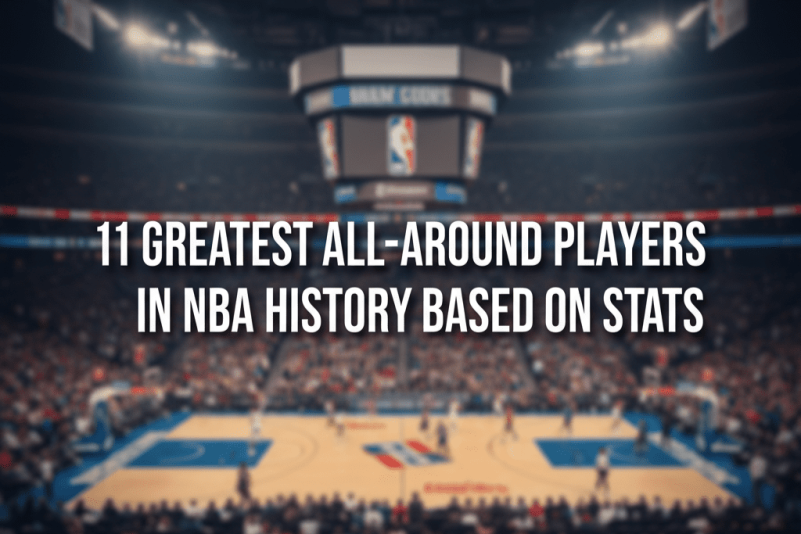
You come to lists like this for proof. Real proof. If you care about the greatest all around players in NBA history based on stats, you want more than nostalgia clips and hot takes. You want the players who filled every column, carried systems, and held up under math. This is for people who remember series, not just moments. For fans who still look up game logs.
Here, all around means this: scoring, playmaking, rebounding, defense, advanced impact, and how often it showed up when it mattered most. In plain words, this is about the players whose numbers prove they could do everything.
Table of Contents
- Why All Around Greatness Matters
- The Complete Packages: 11 All Around Giants
- What Comes Next
Why All Around Greatness Matters
The league has never had more specialists. Spacers in the corner. Rim runners. Switch wings. All useful. But the shape of a franchise, season after season, still bends around the rare player who can control every part of a game.
Coaches design schemes around them. Teammates lean on them on bad shooting nights. Front offices sleep better because those players solve spacing, tempo, and matchups at the same time. That is why the conversation about all around greatness matters. It is not just romance. It is the cleanest way to find who truly lifted everything.
And the numbers, when you stack eras carefully, usually tell you the same few names.
Methodology: Rankings use official NBA and Basketball Reference data, weighting box score production, advanced impact metrics, defense, playmaking, rebounding and longevity, with pace and era adjusted context and close calls decided by sustained playoff impact.
The Complete Packages: 11 All Around Giants
1. LeBron James Complete Two Way Engine
The defining scene is not one play. It is the feeling across two decades that whatever his team lacked, he would plug. Think of 2016 in Oakland, Game 7, tracking down that block, running offense every trip, calling out coverage like a coordinator who also happened to be the best driver on earth.
On paper, LeBron James sits alone. All time leader in points and the only player with at least 30,000 points, 10,000 rebounds and 10,000 assists, plus elite box plus minus and value over replacement through age 40. In simple terms, he scores like a first option and creates like a pure point. Nobody else clears those bars at that volume.
You feel it in how teams and fans talk. Every possession has a plan when he brings the ball up. A coach once said he knew every set in the league. You see him calling out actions for both sides. And he still circles it back to where he is from. “I am just a kid from Akron,” he likes to remind people, and you can tell he means it.
Behind the curtain, stories from staffers are the same: film late, questions constant, details obsessive. That is why even now, when he hits another milestone, the reaction is less surprise and more quiet nod. This is what a complete career looks like.
2. Michael Jordan Relentless Total Weapon
Pick 1988. Jordan averages over 35 points, wins Defensive Player of the Year, leads the league in steals, and erases matchups at both guard spots. One player taking the hardest perimeter assignment, then carrying the offense without blinking.
His career line is clean and cruel. About 30.1 points, 6.2 rebounds, 5.3 assists, 2.3 steals per game, with top tier advanced numbers that still sit near the top of all leaderboards. He was the first to stack a season with 200 steals and 100 blocks, proof his dominance was not just midrange fadeaways.
The emotional part is how heavy it felt when he decided a game was his. You could hear it in road arenas: that low, nervous sound before he rose up. “I can accept failure, but I cannot accept not trying,” he said once, and you watched teammates rise or get left behind.
People remember the last shots. I keep thinking about the nights he spent chasing guards baseline to baseline, then walking straight into 40. That is all around in its meanest form.
3. Magic Johnson Jumbo Floor Maestro
Start with Game 6 in 1980, a rookie walking into center for an injured Kareem, giving the Lakers 42 points, 15 rebounds, 7 assists, and closing a title in Philadelphia. That is problem solving with a smile.
Across his career, Magic sat around 19.5 points, 7.2 rebounds, 11.2 assists, leading the league in assists four times and steals twice, with one of the best assist rates ever. His size let him rebound like a forward and start the break without an outlet. Lineups bent around his passing.
He turned offense into community. “Ask not what your teammates can do for you. Ask what you can do for your teammates,” is a line attached to him often, and even if you have heard it too many times, it fits the way he played. The Forum crowd knew when a no look was coming and stood early.
Privately, coaches tell stories about Magic walking into film already knowing everyone’s responsibilities. That is the point here. His stats validate what your eyes always yelled. He ran everything.
4. Larry Bird Complete Forward Playmaker
Picture him in 1986 calling his shot in the Three Point Contest, walking into the locker room asking who was playing for second, then backing it up. Same confidence showed every night.
Larry Bird finished with about 24.3 points, 10 rebounds, 6.3 assists per game at his peak years, plus elite shooting splits and strong steal numbers, placing him near the top of advanced metrics in his era. A forward who could rebound like a big, pass like a guard, and score from everywhere before spacing became easy.
Fans and rivals talk about his trash talk because it was funny, but the substance was control. He told defenders the spot, then hit it. One coach recalled him as “the best small forward passer I have ever seen” and you watch the tape and nod.
The quieter part is how much he loved making the right read. Teammates remember him more excited about a backdoor dime than a jumper. That is the all-around brain, not just the made shot.
5. Tim Duncan Quiet Two Way Standard
Game 1 of the 2003 Finals is the snapshot. Duncan posts a near quadruple double against New Jersey, swatting shots, calling out rotations, walking his team into sets like a point guard in size 16s.
Over 19 seasons, he put up about 19 points, 10.8 rebounds, 2.2 blocks per game, with some of the best defensive win share totals recorded and steady passing from the high post. He does not lead one loud category. He sits near the top of all the important ones for a very long time.
He said, “Good, better, best. Never let it rest,” and he carried himself that way without drama. Practices, lifts, footwork, angles. The bank shot was not cute. It was a system.
Ask around San Antonio and you hear the same thing. Tim set a standard for doing every job well, every night. If this list has a code, he helped write it.
6. Hakeem Olajuwon Two End Mastery
Think of the 1995 run. He tears through David Robinson and Shaquille O Neal in back to back series, scoring from the post, switching on guards, blocking shots that looked safe. In 1990, he gives Milwaukee a 29, 18, 10, 11 line. That is not a typo.
For his career, he averaged about 21.8 points, 11.1 rebounds, 3.1 blocks, 1.7 steals. He is the only player to post a season with top 10 marks in points, rebounds, steals and blocks, and one of the few to record a verified quadruple double. That is all around through force.
Shaquille O Neal later admitted Hakeem “busted” him and was a different level of problem. Fans in Houston still talk about his footwork like it was art. The Dream Shake came from soccer, handball, hours alone in gyms.
Behind the scenes, big men still fly in to learn from him. That might be the clearest legacy. When great players study you to get more complete, you belong here.
7. Giannis Antetokounmpo Modern Power Creator
The image is fresh. Game 6 in 2021, dropping 50 points, grabbing boards, rotating everywhere, closing the line at the foul stripe while Milwaukee shook. One player covering every weakness in real time.
Stat wise, Giannis has stacked seasons near 30 points, 11 to 13 rebounds, 5 to 6 assists, with elite rim protection and wing level transition creation, plus multiple MVP and Defensive Player of the Year awards. Among active stars, very few match his mix of scoring rate, usage, and defensive numbers.
After that title, he said, “Never get too high. Never get too low,” and you see that calm even when he barrels into five bodies. A fan said, “He plays like a created player on rookie settings,” and while that is dramatic, it tracks how helpless defenses look.
People inside the Bucks talk about his conditioning work, extra film on help angles, the refusal to bail out with jumpers early in his career. The stats show growth in every column. This is what a modern all around superstar looks like when he refuses shortcuts.
8. Nikola Jokic Passing Center Prototype
There is this simple shot from 2023. Jokic grabs the board, never dribbles, throws a touch pass that cuts a defense in half. It looks casual until you try to name another center who sees it that early.
He now owns multiple MVPs, a title, and a season averaging a triple double as a center, sitting near the top of all time box plus minus and offensive efficiency charts, with career numbers over 21 points, 10 rebounds, 7 assists that keep climbing. For bigs, nobody packs scoring, passing, and efficiency together at that scale.
Asked about his triple double season, he shrugged. “It is nice. I do not know what to say. It is good.” That low drama has become part of the charm. Social media lit up with, “He plays like pickup with cheats on,” which sounds silly but nails the feeling.
Teammates tell stories about him remembering every play from games months back. That recall plus that vision is scary. Offenses are now being built around centers who pass like this. That is his ripple.
9. Kevin Garnett Versatile Defensive Core
Go back to 2004. Every Minnesota possession feels like Garnett is involved. Bringing the ball up, screening, posting, rotating, directing. He wins MVP by touching every piece of the floor.
Across his career he gave about 17.8 points, 10 rebounds, 3.7 assists, with elite steal and block totals. He is the only player to reach at least 25,000 points, 10,000 rebounds, 5,000 assists, 1,500 steals and 1,500 blocks. That is literally a checklist of all around production.
“Anything is possible,” he screamed on the Boston floor, which turned into a meme, but if you watched his practices, it came from years of carrying everything in Minnesota. Coaches tell stories about him correcting coverages for everyone, even staff.
A fan said, “He guarded your best scorer and your soul,” after rewatching old series. A bit much. But when the metrics and the tape agree that strongly on versatility, he belongs in this 11.
10. Oscar Robertson Original Triple Double Force
Picture the early 60s film. Slower camera, rougher courts, and Robertson still looks modern. Strong frame, live dribble, firing passes that cut old schemes apart.
He averaged a triple double for a full season and over his first five seasons combined, with career marks around 25.7 points, 7.5 rebounds, 9.5 assists while leading the league in assists multiple times. Before numbers culture, he was already stacking lines that current stars chase.
“Basketball is a team game,” he would say, and it sounds simple until you see how he set tempo. Teammates leaned on his calm. His push for players rights changed how stars think about value, which is another kind of all around.
When people throw triple doubles around now, they sometimes forget the first guy who made it normal box score reading. You correct them with his name.
11. Bill Russell Defensive Brain Of Winning
Close your eyes and think of grainy Finals tape. Russell sprinting in transition, blocking shots so clean they start fast breaks, grabbing everything above the rim, yelling coverages while already in the gap.
His raw scoring sits near 15 points a night, but the rest is absurd. Career rebounding over 22 per game, 11 titles in 13 seasons, and, by estimates, all time leading defensive win shares by a wide margin. Even with incomplete block data, the advanced picture screams control.
“The most important measure of how good a game I played was how much better I made my teammates play,” he said. That is the clean definition of all around impact. Teammates and opponents both describe feeling watched. In a good way if he wore green. In a bad way if you came in the lane.
One comment read, “Modern fans would call him a role player if they only saw the box score.” Maybe. Then they would see the rings, the numbers behind them, and realize this was the template for winning value.
What Comes Next
Look at these 11 and you see a pattern. The game keeps rewarding players who erase labels. Bigs who pass like guards. Wings who screen and post. Guards who rebound, switch, and hold up physically instead of hunting only for highlights.
You can feel another wave coming. Luka, Shai, Wembanyama, players who live in every column already. Social media lit up with, “The next all around monster is already here,” the last time Jokic and Giannis went back and forth. It might be early. It is not wrong to watch closely.
So the real question is this: who is the next player whose stats will leave us no choice but to move one of these names down the list.
ALSO READ
https://info-vista.com/nba-game-rules-new-fans/



